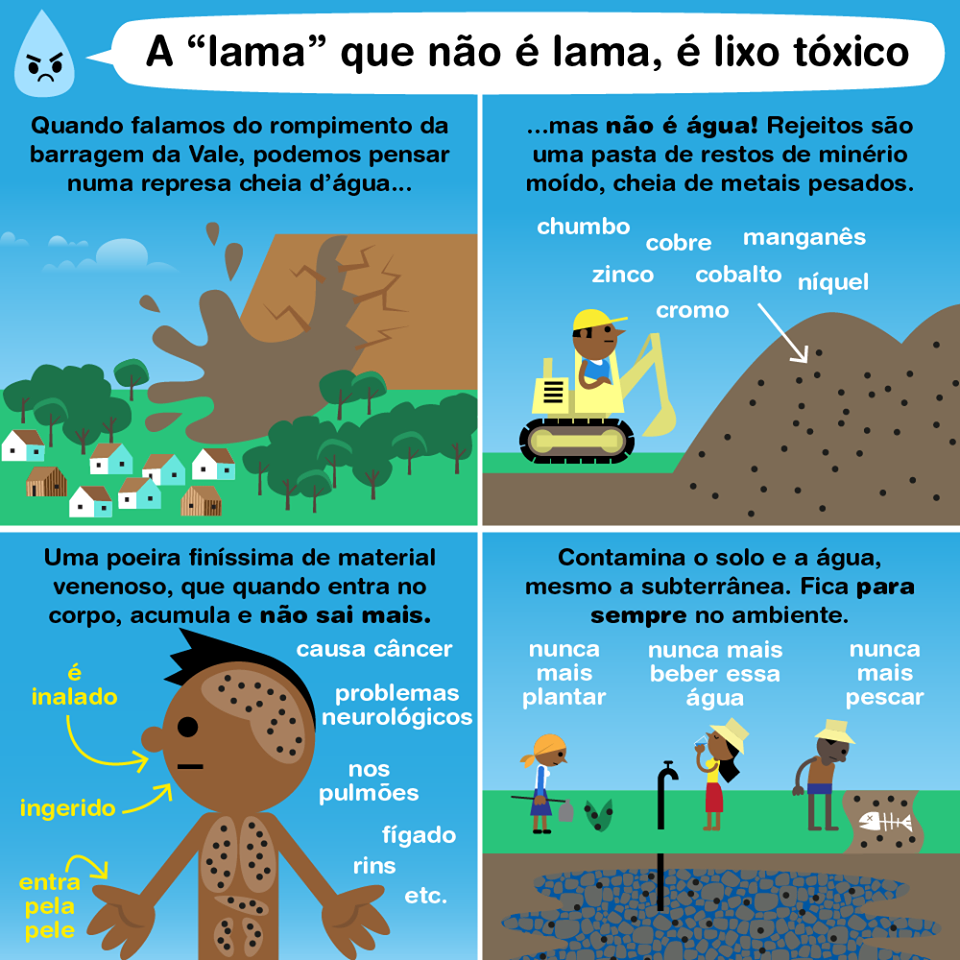The Brumadinho dam, with 12.7 million cubic meters of waste and 86m in height (a 28-story building), accumulated heavy metals, iron and silica residues, toxic sediments that cause serious human and environmental damage (https: // bit.ly/2i1RUbv, https://bit.ly/2MHCDte).
The risk was known: in December, IBAMA had warned about the possibility of breaking (https://glo.bo/2FRC3bL) and its warning was not taken into account. In a decisive meeting, only one vote was against among seven favorable to the demand of Vale, guaranteeing license for the continuity of operations. They did not take into account the risk to the lives of workers and also of the inhabitants of Brumadinho, in addition to all that toxic waste polluting all the water of the Paraopeba basin that covers 48 cities, with a population that exceeds 1.3 million people (https: / / / bit.ly/2G6GVJ6).
The mud is now advancing at 1 km / hour and it is still possible to reach the San Francisco River, in case the dams at the Retiro Baixo Hydroelectric Plant and the Tres Marías do not manage to hold the waste (https://glo.bo / 2RX6X8Q).
The dam that broke in Brumadinho was of “ascending ascending” (that uses the own rejections in its construction, as it was the dam of Mariana) and it was not safe. There are 130 dams like this in the country (https://glo.bo/2MAtGSa).
More information: in Portuguese
“The weight of mining is imposed on Minas and blocks the regulation even after Mariana” – El País, 01/27/2019: https://bit.ly/2RmdDIG
“The dam of the Vale that broke in Brumadinho is equal to that of Mariana” – G1, 01/28/2019: https://glo.bo/2MAtGSa
“Affected cities in the Paraopeba River Basin” – Correio Braziliense, 01/25/2019: https://bit.ly/2G6GVJ6
“Geological Service indicates the possibility of mud reaching the San Francisco River” – G1, 28/01/2019: https://glo.bo/2RX6X8QLe barrage de Brumadinho, avec 12,7 millions de mètres cubes de déchets et 86 m de hauteur (bâtiment de 28 étages), a accumulé des métaux lourds, des résidus de fer et de silice, des sédiments toxiques qui causent de graves dommages à l’homme et à l’environnement (https: // bit.ly/ 2i1RUbv, https://bit.ly/2MHCDte).
Le risque était connu: en décembre, IBAMA avait averti de la possibilité d’une rupture (https://glo.bo/2FRC3bL) et son avertissement n’avait pas été pris en compte. Lors d’une réunion décisive, un seul vote contre sept était favorable à la demande de Vale, ce qui garantissait une licence pour la continuité des opérations. Ils n’ont pas tenu compte des risques pour la vie des travailleurs et des habitants de Brumadinho, en plus de tous ces déchets toxiques qui polluent toutes les eaux du bassin de Paraopeba qui couvre 48 villes, dont la population dépasse 1,3 million d’habitants ( https: / / / bit.ly/2G6GVJ6).
La boue avance maintenant à 1 km / heure et il est encore possible d’atteindre la rivière San Francisco, au cas où les barrages de la centrale hydroélectrique Retiro Baixo et du Tres Marías ne parviendraient pas à retenir les déchets (https: // glo. bo / 2RX6X8Q).
Le barrage qui a éclaté à Brumadinho était d ‘”ascendant ascendant” (qui utilise les propres rejets dans sa construction, car il s’agissait du barrage de Mariana) et il n’était pas sûr. Il y a 130 barrages comme celui-ci dans le pays (https://glo.bo/2MAtGSa).
Plus d’informations: en portugais
“Le poids de l’exploitation minière est imposé à Minas et bloque la réglementation même après Mariana” – El País, 27/01/2019: https://bit.ly/2RmdDIG
“La mère de la vallée qui s’est brisée à Brumadinho est égale à celle de Mariana” – G1, 28/01/2019: https://glo.bo/2MAtGSa
“Villes touchées dans le bassin de la rivière Paraopeba” – Correio Braziliense, 25/01/2019: https://bit.ly/2G6GVJ6
“Le service géologique indique la possibilité que de la boue atteigne la rivière San Francisco” – G1, 28/01/2019: https://glo.bo/2RX6X8Q
“Les métaux lourds: un danger dangereux” – USP: https://bit.ly/2i1RUbv
“Heavy metals: a dangerous danger” – USP: https://bit.ly/2i1RUbv




